Table of contents
- Why Choose Manufacturing Business?
- 1. Eco-Friendly Disposable Tableware
- 2. Organic Spices and Masala Blends
- 3. Customized Wooden Furniture
- 4. Leather Goods Manufacturing
- 5. LED Lights Assembly
- 6. Paper Recycling and Products
- 7. Herbal Cosmetics and Personal Care Products
- 8. Agricultural Equipment Manufacturing
- 9. Pet Food Manufacturing
- 10. Customized Packaging Solutions
- Conclusion
- Frequently Asked Questions (FAQs)
Dreaming of owning a profitable manufacturing business without breaking the bank? You’re in the right place! Starting a “manufacturing business under 30 lakhs” is more achievable than you think. This article explores 10 high-demand manufacturing ideas, providing a roadmap to turn your entrepreneurial aspirations into reality.
Why Choose Manufacturing Business?
Manufacturing isn’t just about creating products; it’s about building tangible value. Here’s a more detailed look at its advantages:
- High-Profit Margins:
- Unlike service-based businesses, manufacturing allows for control over production costs. Efficient processes, bulk material procurement, and optimized workflows can drastically increase profit margins.
- Value addition through processing raw materials into finished goods creates a significant price differential.
- Scalability and Growth:
- Manufacturing businesses can scale production to meet increasing demand. Investing in additional machinery and expanding facilities allows for substantial growth.
- Diversification into related product lines can further enhance scalability.
- Job Creation and Economic Impact:
- Manufacturing contributes significantly to local and national economies by creating employment opportunities.
- Supporting local manufacturing fosters self-reliance and reduces dependence on imports.
- Control Over Product Quality:
- In-house manufacturing provides complete control over product quality, ensuring consistency and meeting customer expectations.
- This control builds trust and brand reputation.
- Innovation and Customization:
- Manufacturing allows for innovation and customization, catering to specific market needs and preferences.
- Developing unique products can create a competitive advantage.
- Asset Building:
- Manufacturing businesses accumulate tangible assets like machinery, equipment, and inventory, which contribute to the business’s overall value.
1. Eco-Friendly Disposable Tableware
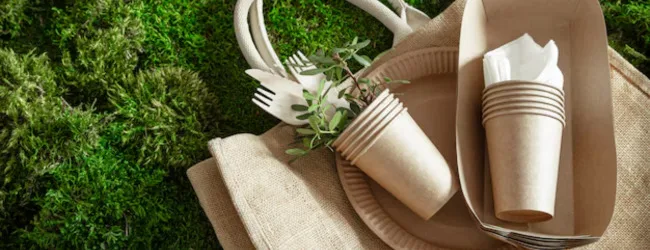
Develop a range of biodegradable tableware, focusing on diverse sizes, shapes, and designs.
- Why this Idea:
- Strict regulations against single-use plastics are increasing globally.
- Consumers are actively seeking sustainable alternatives.
- The food service industry is shifting towards eco-friendly packaging.
- Licenses Required:
- GST registration.
- Factory license (depending on the scale).
- Pollution control board clearances (especially for processing).
- FSSAI, if food will be packaged.
- Investment Required:
- ₹20-25 lakhs: Machinery (molding machines, pressing units, cutting tools), raw material storage, initial raw material purchase, and operational expenses.
- How to Sell:
- Establish partnerships with restaurants, cafes, and catering services.
- Supply to event management companies for eco-conscious events.
- Create an online store and sell through e-commerce platforms.
- Target wholesale distributors.
- Any other Requirements:
- Storage space for raw materials and finished products.
- Quality control measures to ensure biodegradability and durability.
- Marketing and branding to highlight eco-friendly aspects.
- Challenges in the Idea:
- Sourcing consistent and high-quality raw materials.
- Maintaining competitive pricing compared to plastic alternatives.
- Educating the market on the products benefits.
- How to overcome the Challenges:
- Establish long-term contracts with reliable suppliers.
- Optimize production processes to reduce costs.
- Create marketing campaigns that highlight the long-term cost savings to clients.
- Example: A business creates disposable plates from sugarcane bagasse with embedded flower seeds. After use, the plates can be planted, contributing to environmental regeneration.
2. Organic Spices and Masala Blends

Produce authentic, regional spice blends and organic spices with a focus on quality and purity.
- Why this Idea:
- Growing demand for authentic and healthy food ingredients.
- Increased awareness of the health benefits of spices.
- Rising popularity of home cooking and gourmet meals.
- Licenses Required:
- FSSAI license.
- GST registration.
- Trade license.
- Organic certification (if claiming products are organic).
- Investment Required:
- ₹15-20 lakhs: Grinding machines, blending equipment, packaging machines, quality testing equipment, and raw material procurement.
- How to Sell:
- Supply to retail stores, supermarkets, and specialty food shops.
- Create an online store and sell through e-commerce platforms.
- Partner with restaurants and food businesses.
- Target export markets.
- Any other Requirements:
- Quality testing lab to ensure purity and consistency.
- Hygienic packaging to preserve freshness.
- Proper storage facilities for raw materials and finished products.
- Challenges in the Idea:
- Sourcing genuine organic raw materials.
- Maintaining consistent quality and flavor profiles.
- Competition from established brands.
- How to overcome the Challenges:
- Establish direct relationships with organic farmers.
- Implement rigorous quality control measures.
- Create unique packaging and branding that separates your products.
- Example: A business creates a line of “slow-roasted” spice blends, emphasizing traditional cooking methods and unique flavor profiles.
3. Customized Wooden Furniture
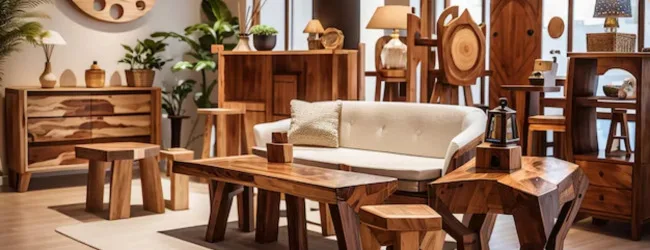
Design and manufacture bespoke wooden furniture, catering to individual client preferences and interior design aesthetics, leveraging modern design software and traditional craftsmanship.
- Why this Idea:
- Growing demand for personalized home and office décor.
- Increasing interest in handcrafted and unique furniture pieces.
- Rise of online platforms connecting designers and customers.
- Licenses Required:
- Trade license.
- GST registration.
- Investment Required:
- ₹25-30 lakhs: Woodworking machinery (CNC routers, planers, sanders), design software (CAD/CAM), finishing tools, raw materials (various types of wood), and workshop space.
- How to Sell:
- Establish an online presence with a portfolio of custom designs.
- Partner with interior designers and architects.
- Create a showroom or workshop for client consultations.
- Sell through online marketplaces specializing in handmade goods.
- Any other Requirements:
- Skilled carpenters and designers.
- Design software proficiency for creating 3D models.
- Quality control measures to ensure precise craftsmanship.
- Good customer communication skills.
- Challenges in the Idea:
- Managing complex customization requests.
- Ensuring timely delivery of bespoke orders.
- Skilled labor shortages.
- How to overcome the Challenges:
- Utilize design software for clear communication and visualization.
- Implement efficient production planning and scheduling.
- Invest in training and apprenticeships to develop skilled labor.
- Example: A business sets up a workshop specializing in modular, space-saving furniture for urban apartments, offering online customization and 3D visualization and using sustainably sourced woods.
💡 Pro Tip: If you want to start a manufacturing business but have too many doubts, connect with a manufacturing business expert from Boss Wallah for guidance – https://bw1.in/1116
4. Leather Goods Manufacturing
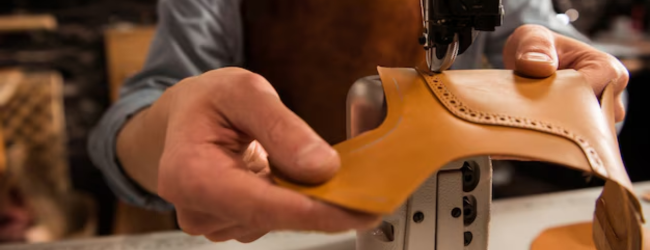
Produce high-quality leather goods, including bags, wallets, belts, and accessories, with a focus on craftsmanship, durability, and unique designs, catering to both domestic and international markets.
- Why this Idea:
- Consistent demand for quality leather products.
- Growing interest in handcrafted and artisanal goods.
- Potential for export to international markets.
- Licenses Required:
- Trade license.
- GST registration.
- Export license (if exporting).
- Investment Required:
- ₹20-25 lakhs: Leather cutting machines, sewing machines, finishing tools, raw materials (various types of leather), and workshop space.
- How to Sell:
- Establish an online store and sell through e-commerce platforms.
- Supply to retail stores and boutiques.
- Participate in trade shows and exhibitions.
- Export to international retailers.
- Any other Requirements:
- Skilled artisans and leatherworkers.
- Quality control measures to ensure durability and finish.
- Design expertise to create unique and appealing products.
- Challenges in the Idea:
- Sourcing high-quality leather from reliable suppliers.
- Competition from established brands and mass-produced goods.
- Maintaining consistent quality.
- How to overcome the Challenges:
- Establish long-term relationships with reputable tanneries.
- Focus on niche markets and unique designs.
- Implement strict quality control checks.
- Example: A company manufactures handcrafted leather travel accessories with a focus on durability and unique designs, targeting the adventure travel market and using vegetable-tanned leather.
5. LED Lights Assembly

Assemble energy-efficient LED lights for residential, commercial, and industrial applications, focusing on quality, reliability, and innovative lighting solutions.
- Why this Idea:
- Growing demand for energy-efficient lighting solutions.
- Government initiatives promoting LED adoption.
- Rapid technological advancements in LED technology.
- Licenses Required:
- BIS certification.
- GST registration.
- Trade license.
- Investment Required:
- ₹15-20 lakhs: Assembly line equipment, testing equipment, soldering machines, component storage, and workshop space.
- How to Sell:
- Supply to retail stores and electrical contractors.
- Create an online store and sell through e-commerce platforms.
- Target commercial and industrial clients.
- Partner with construction companies.
- Any other Requirements:
- Technical expertise in electronics and lighting.
- Quality testing facilities to ensure product reliability.
- After-sales service and support.
- Challenges in the Idea:
- Rapid technological advancements and changing industry standards.
- Competition from established manufacturers.
- Maintaining consistent product quality.
- How to overcome the Challenges:
- Stay updated with the latest LED technology and industry trends.
- Focus on quality and after-sales service.
- Establish strong relationships with component suppliers.
- Example: A company assembles smart LED lighting systems with customizable features, targeting modern homes and offices and offering installation and maintenance services.
6. Paper Recycling and Products
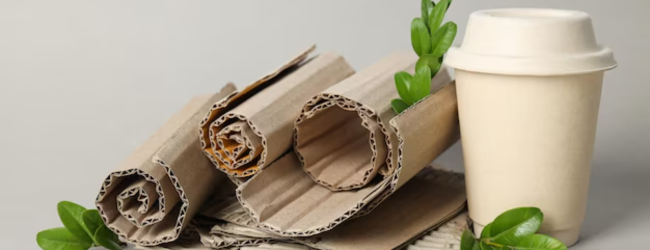
Collect and recycle waste paper to produce a range of eco-friendly paper products, contributing to waste reduction and sustainable resource management.
- Why this Idea:
- Growing environmental awareness and demand for recycled products.
- Increasing focus on waste management and resource conservation.
- Government initiatives promoting recycling and circular economy.
- Licenses Required:
- Pollution control board clearances.
- Trade license.
- GST registration.
- Investment Required:
- ₹25-30 lakhs: Recycling machinery (pulpers, presses, dryers), processing equipment, storage facilities, and transportation.
- How to Sell:
- Supply to packaging industries and stationery shops.
- Create an online store and sell through e-commerce platforms.
- Partner with businesses for waste paper collection.
- Sell bulk materials to other paper product manufacturers.
- Any other Requirements:
- Waste paper collection network.
- Efficient recycling processes and quality control measures.
- Storage space for raw materials and finished products.
- Challenges in the Idea:
- Ensuring consistent and adequate supply of waste paper.
- Managing recycling processes and maintaining quality.
- Competition from established paper manufacturers.
- How to overcome the Challenges:
- Establish partnerships with waste collectors and businesses.
- Optimize recycling processes and invest in efficient machinery.
- Focus on niche products and markets.
- Example: A business recycles paper waste into decorative and protective packaging materials for fragile items, focusing on design and sustainability, and using plant-based inks for printing.
7. Herbal Cosmetics and Personal Care Products

Manufacture natural and herbal cosmetics and personal care products, leveraging traditional formulations and modern scientific research, focusing on quality and efficacy.
- Why this Idea:
- Growing demand for natural and organic products.
- Increasing awareness of the harmful effects of synthetic chemicals.
- Rising popularity of Ayurvedic and herbal remedies.
- Licenses Required:
- FSSAI license.
- Drug license.
- GST registration.
- Investment Required:
- ₹20-25 lakhs: Mixing and blending equipment, packaging machines, quality control lab, raw materials (herbs, oils), and formulation expertise.
- How to Sell:
- Supply to retail stores and pharmacies.
- Create an online store and sell through e-commerce platforms.
- Partner with beauty salons and spas.
- Direct sales through social media.
- Any other Requirements:
- Formulation expertise and knowledge of herbal ingredients.
- Quality control measures to ensure product safety and efficacy.
- Hygienic production facilities.
- Challenges in the Idea:
- Maintaining product consistency and stability.
- Sourcing high-quality herbs and raw materials.
- Competition from established cosmetic brands.
- How to overcome the Challenges:
- Conduct thorough research and development.
- Establish strong relationships with reliable suppliers.
- Focus on unique formulations and quality ingredients.
- Example: A company produces a range of Ayurvedic skincare products using locally sourced herbs, focusing on specific skin types and conditions, and conducting clinical trials to validate product efficacy.
8. Agricultural Equipment Manufacturing
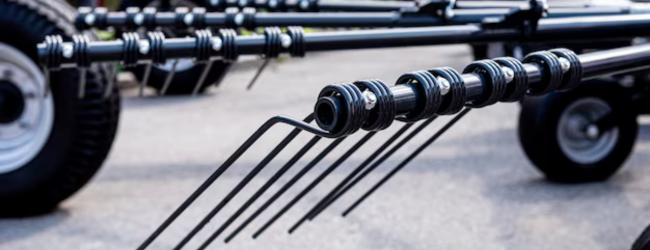
Design and manufacture specialized, small-scale agricultural equipment tailored to the needs of local farmers, focusing on efficiency and affordability.
- Why this Idea:
- Increasing mechanization of agriculture to boost productivity.
- Demand for cost-effective and locally made equipment.
- Government initiatives promoting farm mechanization.
- Licenses Required:
- Trade license.
- GST registration.
- BIS certification (for certain equipment).
- Investment Required:
- ₹25-30 lakhs: Machinery (lathes, milling machines, welding equipment), raw material procurement (steel, alloys), assembly tools, and testing equipment.
- How to Sell:
- Establish partnerships with agricultural supply stores and cooperatives.
- Direct sales to farmers through demonstrations and field days.
- Online sales and e-commerce platforms.
- Participate in agricultural exhibitions and trade shows.
- Any other Requirements:
- Technical expertise in agricultural engineering.
- After-sales service and repair facilities.
- Training programs for farmers on equipment usage.
- Challenges in the Idea:
- Competition from established manufacturers.
- Providing reliable after-sales support in rural areas.
- Adapting to diverse farming practices and terrains.
- How to overcome the Challenges:
- Focus on niche markets and specialized equipment.
- Build strong relationships with local farmers and provide personalized service.
- Offer on-site repair and maintenance services.
- Example: A business manufactures lightweight, portable seed planters designed for small farms, incorporating GPS technology for precise planting and offering on-site maintenance and repair services.
ALSO READ | Contract Manufacturing in International Business: All You Need to Know
9. Pet Food Manufacturing

Produce high-quality, nutritionally balanced pet food with a focus on specific dietary requirements and premium ingredients.
- Why this Idea:
- Growing pet ownership and increasing spending on pet care.
- Demand for specialized pet food for allergies, sensitivities, and life stages.
- Rising awareness of pet nutrition and health.
- Licenses Required:
- FSSAI license.
- Trade license.
- GST registration.
- Animal feed certification.
- Investment Required:
- ₹20-25 lakhs: Mixing and blending equipment, extrusion machines, packaging machines, quality control lab, and raw material procurement.
- How to Sell:
- Supply to pet stores, veterinary clinics, and grooming salons.
- Create an online store and sell through e-commerce platforms.
- Partner with pet influencers and bloggers.
- Offer subscription-based delivery services.
- Any other Requirements:
- Nutritional expertise and formulation development.
- Hygienic production facilities and quality control measures.
- Attractive packaging and branding.
- Challenges in the Idea:
- Maintaining product freshness and palatability.
- Competition from established pet food brands.
- Sourcing high-quality and consistent raw materials.
- How to overcome the Challenges:
- Focus on niche diets and premium ingredients.
- Build strong brand loyalty through quality and customer service.
- Establish long-term contracts with reliable suppliers.
- Example: A company produces organic, grain-free pet food with specific dietary requirements, targeting pet owners with sensitive pets, and offers personalized feeding plans based on breed and age.
10. Customized Packaging Solutions
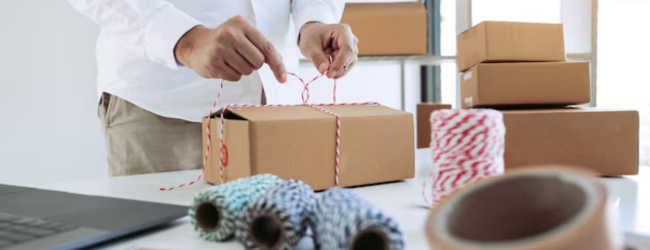
Manufacture customized packaging solutions tailored to the specific needs of various industries, focusing on design, functionality, and sustainability.
- Why this Idea:
- Growing e-commerce industry and demand for protective and branded packaging.
- Increasing focus on sustainable packaging solutions.
- Demand for customized packaging for specialized products.
- Licenses Required:
- Trade license.
- GST registration.
- Investment Required:
- ₹20-25 lakhs: Cutting and die-cutting machines, printing equipment, lamination machines, design software, and raw material procurement.
- How to Sell:
- Supply to e-commerce businesses, retail stores, and food industries.
- Offer design and prototyping services.
- Create an online portfolio and showcase customized packaging solutions.
- Target specific industries with specialized packaging needs.
- Any other Requirements:
- Design software and skilled designers.
- Quality control measures to ensure packaging integrity.
- Efficient logistics and delivery systems.
- Challenges in the Idea:
- Managing diverse customization requests and tight deadlines.
- Ensuring timely delivery and maintaining quality.
- Adapting to changing packaging trends and technologies.
- How to overcome the Challenges:
- Use design software for efficient communication and prototyping.
- Optimize production processes and implement quality control systems.
- Invest in advanced machinery and stay updated with industry trends.
- Example: A business creates customized, eco-friendly packaging boxes for online retailers, focusing on branding and product protection, and offers virtual reality previews of packaging designs.
ALSO READ | 10 Most Profitable Manufacturing Business Ideas in India
Need Expert Guidance?
Starting a business can be challenging, but you don’t have to do it alone! At Boss Wallah, our 2,000+ business experts are ready to provide valuable insights and guidance. Whether you need help with marketing, finance, sourcing, or any other area of any business, our business experts are here to help you succeed: https://bw1.in/1116
Confused about Which Business to Start?
Want to start your own business but unsure which one to choose? Explore Boss Wallah, where you’ll find 500+ courses by successful business owners, featuring practical, step-by-step guides on starting and growing various businesses.
Find your perfect business idea today: https://bw1.in/1111
Conclusion
Starting a “manufacturing business under 30 lakhs” is a viable and profitable venture. By choosing the right idea, obtaining necessary licenses, and implementing effective marketing strategies, you can achieve substantial success.
Frequently Asked Questions (FAQs)
1. What are the key factors to consider before starting a manufacturing business?
Market demand, raw material availability, required licenses, and investment capacity.
2. How can I secure funding for a manufacturing business under 30 lakhs?
Small business loans, government schemes, and personal savings.
3. What licenses are typically required for manufacturing businesses in India?
GST registration, trade license, FSSAI license (for food products), and pollution control board clearances.
4. How can I market my manufactured products effectively?
Online marketing, social media, participating in trade shows, and building strong relationships with distributors.
5. What are the common challenges in manufacturing businesses?
Raw material sourcing, quality control, skilled labor shortages, and competition.
6. How can I ensure the quality of my manufactured products?
Implement strict quality control measures, use high-quality raw materials, and conduct regular testing.
7. Is it better to focus on niche markets or mass production?
For small businesses, focusing on niche markets can be more effective.
8. How do I manage inventory and logistics in a manufacturing business?
Use inventory management software, establish efficient supply chains, and partner with reliable logistics providers.



